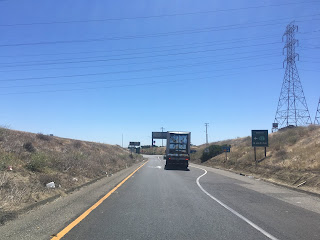The current California State Route 207 ("CA 207") is a one mile State Highway which connects California State Route 4 near Lake Alpine to the Bear Valley Ski Area. CA 207 is located within the Sierra Nevada Mountains of Alpine County.
Part 1; the history of California State Route I
The original CA 207 was created during the 1964 State Highway Renumbering out of Legislative Route 121 ("LRN 121") from CA 152 north to CA 33 in Santa Nella. The original CA 207 was a short 3 mile highway which was aligned over an important regional connecting corridor. LRN 121 was added to the State Highway System in 1933 according to CAhighways.org. The first CA 207 can be seen on the 1964 Division of Highways State Map.
For a 3 mile route the first CA 207 had a lot going on as it would have quickly had a junction with the Medeiros Recreation Area almost immediately north of CA 152.
The first CA 207 would have crossed the O'Neill Forebay followed by Delta Mendota Canal before entering Santa Nella.
The first CA 207 would have terminated at CA 33/Henry Miller Avenue.
Part 3; the history of California State Route 207 II
According to CAhighways.org the second CA 207 was added to the State Highway System as part of 1979 Legislative Chapter 572. The second CA 207 originally carried a definition of Lake Alpine to the Mount Reba Ski Area. The second CA 207 first appears on the 1981 Caltrans State Highway Map.
The Bear Valley Ski Area traces it's history to Harvey Blood's Toll Station on the Ebbetts Pass Road which became a tolled facility in the early 1860s. The first written documentation referring to the area as "Bear Valley" is first cited in 1869 according to bearvalley.com. In 1910 the Ebbetts Pass Toll Road was made a free highway as it was added to the State Highway System as Legislative Route 24 as part of the 1909 First State Highway Bond Act. Blood's Station continued to operate until 1920 when it was sold to the Bishop Mining and Cattle Company.
In 1952 the Orvis Family purchased 480 acres of land from the Bishop Mining and Cattle Company. The Orvis Family later purchased 400 additional acres of Stanislaus National Forest parcels north of Bear Valley towards Mount Reba in 1963 with the intentions of building a ski resort. The Mount Reba Ski Area opened in 1967 (along with what would become CA 207 II) for the winter ski season. In June of 1991 the Mount Reba Ski Area was purchased and renamed to the Bear Valley Ski Area.
Part 4; a drive on California State Route 207 II
CA 4 eastbound intersects modern CA 207 at Postmile ALP R2.906. CA 4 eastbound has two reassurance shields for CA 207 mounted above light posts approaching the actual junction.
The 24% gradient warning for CA 4 eastbound over Ebbetts Pass can be found at the junction with modern CA 207. The 24% grades ahead mostly apply in reality to Pacific Grade Summit but nonetheless are very real.
Modern CA 207 travels northwest from CA 207 and has at least one reassurance shield. Modern CA 207 is known as "Mount Reba Road" and State Maintenance ends at Postmile ALP 1.36. CA 207 ends within view of Mount Reba.




























Comments